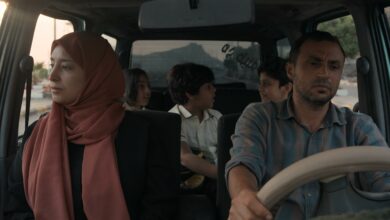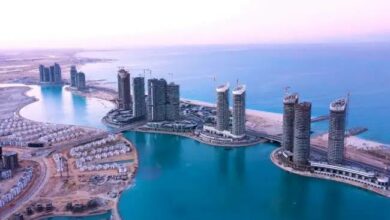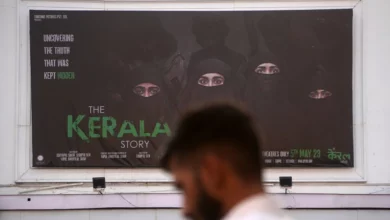The Arab Shorts 2010: Independent Short Films and Media Art Festival opened last Saturday at the Goethe Institute in Cairo with a screening of two curated short film programs by Alexandrian filmmaker Emad Mabrouk and Amman-based curator Ala’ Younis. The festival’s artistic director, German filmmaker Marcel Schwierin, compares curating short films to creating a single film from a rich film archive, unfolding a narrative.
The theme for this year’s screening program was post-realist reality and it was meant to convey the complex social and political issues pertinent to the Arab world through six experimental film programs. This year, program curators were liberated from national representation and encouraged to choose their selections according to theme.
Mabrouk’s program, “Egypt – Post-realist Reality,” presented five short films that reflect the diversity in visual qualities, cinematographic techniques and themes that have characterized Egyptian independent short films over the past few years. Mabrouk prefers to refer to his selections as “underground cinema” rather than “independent films,” which are often associated with funding models.
In the 15-minute feature film “Pale Red,” Egyptian filmmaker Mohamed Hammad employs the symbolism in color to explore the complexity of femininity through the life of the film’s teenage protagonist, Shaima. Mocked by her schoolmates for wearing an old pair of underwear, Shaima buys flashy red underwear. Out of fear of criticism from the neighbors, who would see the red underwear drying outside, her grandmother forces Shaima to wash them with chlorine until the color fades.
The script and aesthetics of the movie highlight the emotionally intense lives of the two women. Prominent film director Nabila Lotfy has praised the high sensibility of the film in presenting women’s issues that are often avoided by mainstream cinema.
Another film in Mabrouk’s program was “Atef,” a 6-minute film by Egyptian filmmaker Emad Maher. Maher blends conventional cinematography with computer animation, exploring the impact of surreal backgrounds on plot. The humorous film shows two strangers engaged in a conversation about the prose of Youssef Kamal on an imaginary street in Alexandria. They are brought together by mere coincidence as each waits under the rain for a man named Atef.
Both films received international recognition, explained Mabrouk, which proves the strength of independent filmmaking in Egypt. Long independent feature films such as “Microphone” by Ahmed Abdalah and “Hawi” by Ibrahim el-Batout have also received international awards. “Microphone” and “Hawi” will be commercially screened in Egypt within the next few months, adds Mabrouk. Egyptian short films are following suit toward having a greater presence on the local and international film scenes, he explained.
Younis’s program, “To Know the Arab Terrain: Movements To, From and Within,” presented eight short films by visual artists of Arab origin. The program explored terms used to define the Arab identity by both Arabs and foreigners. The films play on concepts of translation and re-narration made possible through visual images, and how much they are influenced by preconceptions of a region or culture, explained Younis.
For instance, Egyptian artist Wael Shawky is known for recreating historical incidents using visual motifs that are stereotypically Middle Eastern. In Shawky’s “Telematch Shelter,” the artist borrows images of desert landscapes to critique hierarchical notions of civilization. Bedouin children walk in and out of a cave in a desert, attempting to abandon their nomadic lifestyle in favor of starting an agricultural community.
In “Aesthetics of Disappearance,” Jananne al-Aini explores the meaning of territory by filming southern Jordan from an airplane; the beautiful but uninhabited landscapes have not been touched by modern civilization.
Distribution remains the main obstacle facing short films worldwide, explained Schwierin. Over the past year, Arab Shorts has been working on creating a platform for the screening, discussion and promotion of Arab short films through the online programs, festival screenings, discussions and a screening lounge that offers more than 160 films for professionals.
Online platforms remain the most suitable media for screening short films, added Schwierin. Movie theaters and television stations are not interested in short films for format reasons, and DVD companies need star names to sell. But short films are compatible with the limited bandwidth of the Internet and the Internet user’s short attention span, he added. “We nevertheless recognize the limitations of existing online platforms and are trying to work through them,” he explained. Existing platforms such as YouTube and Vimeo suffer from aesthetic problems in presentation. On these popular online platforms, experimental films are forced to compete with amateur videos.
One of the main objectives of the Arab Shorts is to “reorganize the Internet” in ways that do not compromise the aesthetic and conceptual elements of the films, he explained. They are also trying to compensate for the limited feedback that filmmakers receive from online audiences by screening the films for the public at the festival.
It remains a challenge to make certain that by promoting the films to a wider audience they do not compromise their chances of being selected for international film festival screenings. The organizers are trying to address this with the new addition of the screening lounge, which allows festival curators to review films that are not available online for possible inclusion in their selections. Schwierin describes Arab Shorts as a “project in process.”




